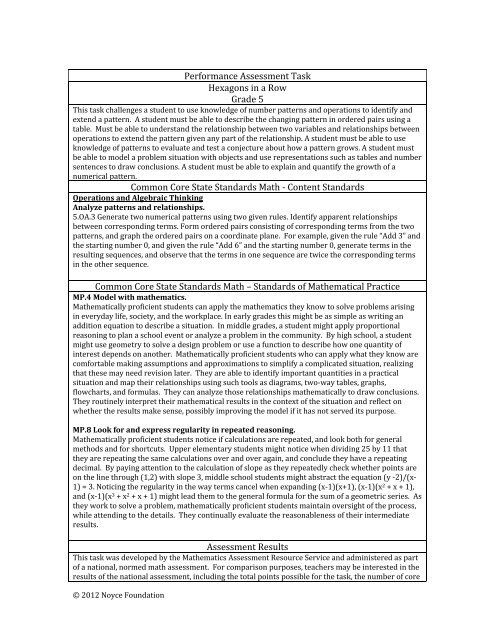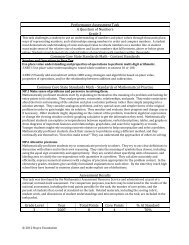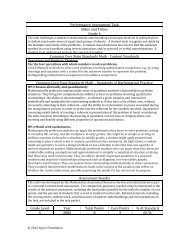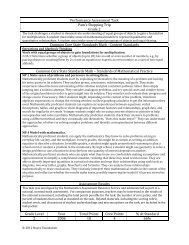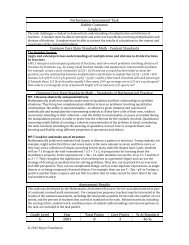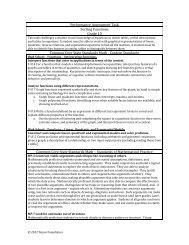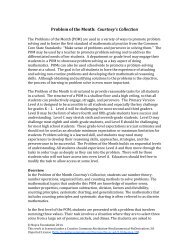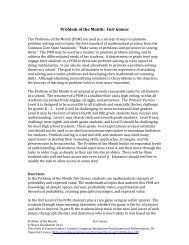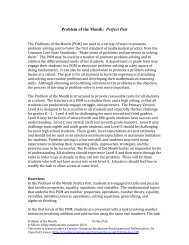Hexagons in a Row - Inside Mathematics
Hexagons in a Row - Inside Mathematics
Hexagons in a Row - Inside Mathematics
- No tags were found...
Create successful ePaper yourself
Turn your PDF publications into a flip-book with our unique Google optimized e-Paper software.
Performance Assessment Task<br />
<strong>Hexagons</strong> <strong>in</strong> a <strong>Row</strong><br />
Grade 5<br />
This task challenges a student to use knowledge of number patterns and operations to identify and<br />
extend a pattern. A student must be able to describe the chang<strong>in</strong>g pattern <strong>in</strong> ordered pairs us<strong>in</strong>g a<br />
table. Must be able to understand the relationship between two variables and relationships between<br />
operations to extend the pattern given any part of the relationship. A student must be able to use<br />
knowledge of patterns to evaluate and test a conjecture about how a pattern grows. A student must<br />
be able to model a problem situation with objects and use representations such as tables and number<br />
sentences to draw conclusions. A student must be able to expla<strong>in</strong> and quantify the growth of a<br />
numerical pattern.<br />
Common Core State Standards Math ‐ Content Standards<br />
Operations and Algebraic Th<strong>in</strong>k<strong>in</strong>g<br />
Analyze patterns and relationships.<br />
5.OA.3 Generate two numerical patterns us<strong>in</strong>g two given rules. Identify apparent relationships<br />
between correspond<strong>in</strong>g terms. Form ordered pairs consist<strong>in</strong>g of correspond<strong>in</strong>g terms from the two<br />
patterns, and graph the ordered pairs on a coord<strong>in</strong>ate plane. For example, given the rule “Add 3” and<br />
the start<strong>in</strong>g number 0, and given the rule “Add 6” and the start<strong>in</strong>g number 0, generate terms <strong>in</strong> the<br />
result<strong>in</strong>g sequences, and observe that the terms <strong>in</strong> one sequence are twice the correspond<strong>in</strong>g terms<br />
<strong>in</strong> the other sequence.<br />
Common Core State Standards Math – Standards of Mathematical Practice<br />
MP.4 Model with mathematics.<br />
Mathematically proficient students can apply the mathematics they know to solve problems aris<strong>in</strong>g<br />
<strong>in</strong> everyday life, society, and the workplace. In early grades this might be as simple as writ<strong>in</strong>g an<br />
addition equation to describe a situation. In middle grades, a student might apply proportional<br />
reason<strong>in</strong>g to plan a school event or analyze a problem <strong>in</strong> the community. By high school, a student<br />
might use geometry to solve a design problem or use a function to describe how one quantity of<br />
<strong>in</strong>terest depends on another. Mathematically proficient students who can apply what they know are<br />
comfortable mak<strong>in</strong>g assumptions and approximations to simplify a complicated situation, realiz<strong>in</strong>g<br />
that these may need revision later. They are able to identify important quantities <strong>in</strong> a practical<br />
situation and map their relationships us<strong>in</strong>g such tools as diagrams, two‐way tables, graphs,<br />
flowcharts, and formulas. They can analyze those relationships mathematically to draw conclusions.<br />
They rout<strong>in</strong>ely <strong>in</strong>terpret their mathematical results <strong>in</strong> the context of the situation and reflect on<br />
whether the results make sense, possibly improv<strong>in</strong>g the model if it has not served its purpose.<br />
MP.8 Look for and express regularity <strong>in</strong> repeated reason<strong>in</strong>g.<br />
Mathematically proficient students notice if calculations are repeated, and look both for general<br />
methods and for shortcuts. Upper elementary students might notice when divid<strong>in</strong>g 25 by 11 that<br />
they are repeat<strong>in</strong>g the same calculations over and over aga<strong>in</strong>, and conclude they have a repeat<strong>in</strong>g<br />
decimal. By pay<strong>in</strong>g attention to the calculation of slope as they repeatedly check whether po<strong>in</strong>ts are<br />
on the l<strong>in</strong>e through (1,2) with slope 3, middle school students might abstract the equation (y ‐2)/(x‐<br />
1) = 3. Notic<strong>in</strong>g the regularity <strong>in</strong> the way terms cancel when expand<strong>in</strong>g (x‐1)(x+1), (x‐1)(x 2 + x + 1),<br />
and (x‐1)(x 3 + x 2 + x + 1) might lead them to the general formula for the sum of a geometric series. As<br />
they work to solve a problem, mathematically proficient students ma<strong>in</strong>ta<strong>in</strong> oversight of the process,<br />
while attend<strong>in</strong>g to the details. They cont<strong>in</strong>ually evaluate the reasonableness of their <strong>in</strong>termediate<br />
results.<br />
Assessment Results<br />
This task was developed by the <strong>Mathematics</strong> Assessment Resource Service and adm<strong>in</strong>istered as part<br />
of a national, normed math assessment. For comparison purposes, teachers may be <strong>in</strong>terested <strong>in</strong> the<br />
results of the national assessment, <strong>in</strong>clud<strong>in</strong>g the total po<strong>in</strong>ts possible for the task, the number of core<br />
© 2012 Noyce Foundation
po<strong>in</strong>ts, and the percent of students that scored at standard on the task. Related materials, <strong>in</strong>clud<strong>in</strong>g<br />
the scor<strong>in</strong>g rubric, student work, and discussions of student understand<strong>in</strong>gs and misconceptions on<br />
the task, are <strong>in</strong>cluded <strong>in</strong> the task packet.<br />
Grade Level Year Total Po<strong>in</strong>ts Core Po<strong>in</strong>ts % At Standard<br />
5 2006 8 4 69%<br />
© 2012 Noyce Foundation
<strong>Hexagons</strong> <strong>in</strong> a <strong>Row</strong><br />
This problem gives you the chance to:<br />
• f<strong>in</strong>d a pattern <strong>in</strong> a sequence of diagrams<br />
• use the pattern to make a prediction<br />
Joe uses toothpicks to make hexagons <strong>in</strong> a row.<br />
1 hexagon<br />
6 toothpicks<br />
2 hexagons<br />
11 toothpicks<br />
3 hexagons<br />
16 toothpicks<br />
4 hexagons<br />
Joe beg<strong>in</strong>s to make a table to show his results.<br />
Number of hexagons <strong>in</strong> a row 1 2 3 4<br />
Number of toothpicks 6 11<br />
1. Fill <strong>in</strong> the empty spaces <strong>in</strong> Joe’s table of results.<br />
Copyright © 2006 by <strong>Mathematics</strong> Assessment Page 2<br />
<strong>Hexagons</strong> <strong>in</strong> a <strong>Row</strong> Test 5<br />
Resource Service. All rights reserved.
2. How many toothpicks does Joe need to make 5 hexagons? ______________<br />
Expla<strong>in</strong> how you figured it out.<br />
________________________________________________________________<br />
________________________________________________________________<br />
3. How many toothpicks does Joe need to make 12 hexagons? ______________<br />
Expla<strong>in</strong> how you figured it out.<br />
________________________________________________________________<br />
________________________________________________________________<br />
________________________________________________________________<br />
4. Joe has 76 toothpicks.<br />
How many hexagons <strong>in</strong> a row can he make?<br />
Expla<strong>in</strong> how you figured it out.<br />
__________________<br />
________________________________________________________________<br />
________________________________________________________________<br />
________________________________________________________________<br />
8<br />
Copyright © 2006 by <strong>Mathematics</strong> Assessment Page 3 <strong>Hexagons</strong> <strong>in</strong> a <strong>Row</strong> Test 5<br />
Resource Service. All rights reserved.
<strong>Hexagons</strong> <strong>in</strong> a <strong>Row</strong><br />
Rubric<br />
The core elements of performance required by this task are:<br />
• f<strong>in</strong>d a pattern <strong>in</strong> a sequence of diagrams<br />
• use the pattern to make a prediction<br />
Based on these, credit for specific aspects of performance should be assigned as follows<br />
1. Gives correct answers: 16 and 21<br />
2. Gives correct answer: 26<br />
Gives correct explanation such as: I added on 5: accept diagrams<br />
3. Gives correct answer: 61<br />
Gives correct explanation such as:<br />
The first hexagon needs 6 toothpicks; each extra needs 5.<br />
6 + 11 x 5 =<br />
Accept diagrams or add<strong>in</strong>g on.<br />
4. Gives correct answer: 15<br />
po<strong>in</strong>ts<br />
1<br />
1<br />
1<br />
1<br />
1<br />
1<br />
section<br />
po<strong>in</strong>ts<br />
1<br />
2<br />
2<br />
Gives correct explanation such as:<br />
The first hexagon needs 6 toothpicks; each extra needs 5.<br />
76 – 1 = 75, 75 ÷ 5 = 15<br />
Accept diagrams<br />
1<br />
1<br />
3<br />
Total Po<strong>in</strong>ts 8
5 th Grade – Task 2: <strong>Hexagons</strong> <strong>in</strong> a <strong>Row</strong><br />
Work the task. Look at the rubric.<br />
What do you th<strong>in</strong>k are the key mathematics the task is try<strong>in</strong>g to assess?<br />
Look at student work for part 3. How many of your students put:<br />
61 60 66 63 62 56 Other<br />
What k<strong>in</strong>d of strategies did your students use?<br />
21x3=<br />
63<br />
Cont<strong>in</strong>ue<br />
the table<br />
Multiply<br />
by5+1<br />
Repeated<br />
addition<br />
Draw<br />
&<br />
Count<br />
Multiply<br />
by5+6<br />
Multiply<br />
by6–<br />
shared<br />
sides<br />
7x5 +<br />
21<br />
• Which of these strategies works? Which doesn’t? Can you expla<strong>in</strong> us<strong>in</strong>g the<br />
diagram why it works or what needs to be changed to make it work?<br />
• Does this exercise make you th<strong>in</strong>k about the big ideas of the task differently?<br />
Now look at student work for part 4. How many of your students put:<br />
15 14 15r1 13 More than<br />
20<br />
Other<br />
Besides cont<strong>in</strong>u<strong>in</strong>g the table and draw<strong>in</strong>g and count<strong>in</strong>g, what strategies helped<br />
students to get the correct answer?<br />
What did they have to th<strong>in</strong>k about <strong>in</strong> terms of the structure of the pattern to work<br />
backwards?<br />
Fifth Grade – 2006<br />
Pg.<br />
(c) Noyce Foundation 2006. To reproduce this document, permission must be granted by the Noyce Foundation:<br />
<strong>in</strong>fo@noycefdn.org.<br />
27
Look<strong>in</strong>g at student work on <strong>Hexagons</strong> <strong>in</strong> a <strong>Row</strong><br />
Student A notices that while all hexagons have 6, when then jo<strong>in</strong> together one side overlaps. The<br />
student is able to quantify the overlaps by subtract<strong>in</strong>g out the number of hexagons m<strong>in</strong>us one. This<br />
generalization will be expressed algebraically, at later grades, as t= 6x – (x-1); where t= number of<br />
toothpicks and x = number of hexagons, (x-1) represents the number of overlaps for any part of the<br />
sequence.<br />
Student A<br />
Fifth Grade – 2006<br />
Pg.<br />
(c) Noyce Foundation 2006. To reproduce this document, permission must be granted by the Noyce Foundation:<br />
<strong>in</strong>fo@noycefdn.org.<br />
28
Student B is able to th<strong>in</strong>k about how the first term is different from the other terms and can use that<br />
strategy to solve the problem. Notice that the student knows that the 6 must be added back <strong>in</strong> to the<br />
pattern for part four and that the 6 represents and additional tile. This idea might be expressed<br />
symbolically as t=5(x-1)+6.<br />
Student B<br />
Fifth Grade – 2006<br />
Pg.<br />
(c) Noyce Foundation 2006. To reproduce this document, permission must be granted by the Noyce Foundation:<br />
<strong>in</strong>fo@noycefdn.org.<br />
29
Student B2 also th<strong>in</strong>ks about the 6+5+5+5. ...Howeverthestudentisabletogeneralizetoaruleand<br />
use <strong>in</strong>verse operations <strong>in</strong> part 5 of the task. So if the rule is t=5(x-1)+6, the <strong>in</strong>verse would be x= [(t-<br />
6) /5] +1.<br />
Student B2<br />
Fifth Grade – 2006<br />
Pg.<br />
(c) Noyce Foundation 2006. To reproduce this document, permission must be granted by the Noyce Foundation:<br />
<strong>in</strong>fo@noycefdn.org.<br />
30
Student C is able to use multiplicative th<strong>in</strong>k<strong>in</strong>g to see the number of groups of 5 that need to be<br />
added. Be<strong>in</strong>g able to use a unit, <strong>in</strong> this case a unit of 5, to measure up or down is an important step<br />
<strong>in</strong> develop<strong>in</strong>g proportional reason<strong>in</strong>g.<br />
Student C<br />
Fifth Grade – 2006<br />
Pg.<br />
(c) Noyce Foundation 2006. To reproduce this document, permission must be granted by the Noyce Foundation:<br />
<strong>in</strong>fo@noycefdn.org.<br />
31
Student D is able to come up with the generalization of 5x+1 <strong>in</strong> a verbal form, and use that<br />
generalization to solve all the parts of the task.<br />
Student D<br />
Fifth Grade – 2006<br />
Pg.<br />
(c) Noyce Foundation 2006. To reproduce this document, permission must be granted by the Noyce Foundation:<br />
<strong>in</strong>fo@noycefdn.org.<br />
32
Student E makes a similar mathematical justification.<br />
Student E<br />
Fifth Grade – 2006<br />
Pg.<br />
(c) Noyce Foundation 2006. To reproduce this document, permission must be granted by the Noyce Foundation:<br />
<strong>in</strong>fo@noycefdn.org.<br />
33
Student F is able to complete a table by add<strong>in</strong>g 5’s to solve much of the task. However <strong>in</strong> part four,<br />
the student tries to use proportional reason<strong>in</strong>g if 4 hexagons are 21, then 21 x 3 should equal 12<br />
hexagons. This reason<strong>in</strong>g does not work, because the constant is now <strong>in</strong>cluded <strong>in</strong> the total 3 times<br />
<strong>in</strong>stead of just once.<br />
Student F<br />
Fifth Grade – 2006<br />
Pg.<br />
(c) Noyce Foundation 2006. To reproduce this document, permission must be granted by the Noyce Foundation:<br />
<strong>in</strong>fo@noycefdn.org.<br />
34
Student G understands that the growth rate is 5, but does not know how to add <strong>in</strong> the constant. In<br />
part three the student leaves out the constant, us<strong>in</strong>g a rule of 5x <strong>in</strong>stead of<br />
5x +1. In part four the student is unable to account for the extra “one”.<br />
Student G<br />
By fifth grade, students should notice equal groups as they appear <strong>in</strong> a pattern. Students should start<br />
to feel comfortable measur<strong>in</strong>g <strong>in</strong> units other than one, such as the “fiveness” represented <strong>in</strong> this<br />
pattern. Students should be able to start see<strong>in</strong>g equal groups as contexts for multiplication and<br />
division. Students at this grade level are striv<strong>in</strong>g for general rules about patterns, and some come up<br />
with verbal generalizations similar to the ones we want algebra students to express symbolically at<br />
later grades.<br />
8% of the students were able to express a generalization <strong>in</strong> words equivalent to 5x+1 or 5(x-1)+6.<br />
2% made generalizations that accounted for the number of overlaps. 4% of the students were able to<br />
bundle the 5’s <strong>in</strong> groups (5 x3 or 5 x 6) and add it on to a previous quantity rather than do<strong>in</strong>g a str<strong>in</strong>g<br />
of addition. 3.5% of the students could account for the difference <strong>in</strong> the first term (6+5+5+5…).<br />
38% of the students used add<strong>in</strong>g 5’s or extend<strong>in</strong>g the table. 13% used a draw and count strategy<br />
correctly, while another 1% made errors us<strong>in</strong>g draw and count.<br />
Fifth Grade – 2006<br />
Pg. 35<br />
(c) Noyce Foundation 2006. To reproduce this document, permission must be granted by the Noyce Foundation:<br />
<strong>in</strong>fo@noycefdn.org.
Incorrect strategies <strong>in</strong>cluded 5% try<strong>in</strong>g to use a times 5 strategy. Less than 1% used a times 6<br />
strategy. 8% tried multiply<strong>in</strong>g or add<strong>in</strong>g parts of the table (6 th term x 2 = 12 th term) thus <strong>in</strong>clud<strong>in</strong>g<br />
the constant more than once. 1% had visual discrim<strong>in</strong>ation problems <strong>in</strong> their draw<strong>in</strong>gs. 2% had a<br />
rule of 5x + (wrong constant).<br />
When look<strong>in</strong>g at the papers for 5 th grade, I looked at the strategies for deal<strong>in</strong>g with the <strong>in</strong>verse<br />
relationships <strong>in</strong> part 4 separately. 2.5% of the students could divide by 5 and then expla<strong>in</strong> what the<br />
rema<strong>in</strong>der meant. 12% understood that they needed to divide by 5, but couldn’t expla<strong>in</strong> the<br />
rema<strong>in</strong>der. 8.5% of the students looked at the growth (76-61 or 76-26) and then were able to f<strong>in</strong>d<br />
the number of additional hexagons needed from the base number of hexagons. 12% were able to use<br />
generalizations ((76-6)/5 +1 or (76-1)/5). 6% tried to f<strong>in</strong>d the number for 76 hexagons <strong>in</strong>stead of 76<br />
toothpicks. 15% used draw and count for this part of the task, but for about 6%, this was the only<br />
part of the task where they reverted to a draw<strong>in</strong>g strategy. 21% cont<strong>in</strong>ued the table and 23% added<br />
on by 5’s.<br />
Fifth Grade – 2006<br />
Pg.<br />
(c) Noyce Foundation 2006. To reproduce this document, permission must be granted by the Noyce Foundation:<br />
<strong>in</strong>fo@noycefdn.org.<br />
36
Fifth Grade<br />
5 th Grade Task 2 <strong>Hexagons</strong> <strong>in</strong> a <strong>Row</strong><br />
Student Task<br />
Core Idea 3<br />
Patterns,<br />
Functions,<br />
and Algebra<br />
F<strong>in</strong>d a pattern <strong>in</strong> a sequence of diagrams and use the pattern to make<br />
predictions. F<strong>in</strong>d the total number of iterations of hexagons that can be<br />
made when the total number of toothpicks is given.<br />
Understand patterns and use mathematical models such as<br />
algebraic symbols and graphs to represent and understand<br />
quantitative relationships.<br />
• Represent and analyze patterns and functions us<strong>in</strong>g words,<br />
tables, and graphs<br />
• Investigate how a change <strong>in</strong> one variable relates to a change <strong>in</strong> a<br />
second variable.<br />
• F<strong>in</strong>d the results of a rule for a specific value<br />
• Use <strong>in</strong>verse operations to solve multi-step problems<br />
• Use concrete, pictorial, and verbal representations to solve<br />
problems <strong>in</strong>volv<strong>in</strong>g unknowns<br />
<strong>Mathematics</strong> <strong>in</strong> the task:<br />
• Extend a geometric pattern<br />
• Useatable<br />
• Work backwards<br />
• Understand the idea of a constant<br />
• Recognize when a pattern is not proportional<br />
Based on teacher observations, this is what fifth graders knew and were able to do:<br />
• Addontoanexist<strong>in</strong>gpattern<br />
• Recognize and verbalize a pattern (go<strong>in</strong>g up by 5’s)<br />
• Add on, multiply or divide by 5<br />
Areas of difficulty for fifth graders:<br />
• Multiply<strong>in</strong>g by 6 <strong>in</strong>stead of 5 (not notic<strong>in</strong>g the overlap when hexagons are connected)<br />
• Not see<strong>in</strong>g that the first hexagon has needs more toothpicks than the rest<br />
• See<strong>in</strong>g generalizable rules<br />
• Draw<strong>in</strong>g and count<strong>in</strong>g accurately<br />
• Deal<strong>in</strong>g with the shared sides<br />
Strategies used by successful students:<br />
• Draw pictures<br />
• Extended the table<br />
• See<strong>in</strong>g how the structural pattern of the hexagons grew and us<strong>in</strong>g that to form a rule<br />
Fifth Grade – 2006<br />
Pg.<br />
(c) Noyce Foundation 2006. To reproduce this document, permission must be granted by the Noyce Foundation:<br />
<strong>in</strong>fo@noycefdn.org.<br />
37
MARS Test Task 2 Frequency Distribution and Bar Graph, Grade 5<br />
Task 2 – <strong>Hexagons</strong> <strong>in</strong> a <strong>Row</strong><br />
Mean: 5.14 StdDev: 2.71<br />
Figure 35: Bar Graph of MARS Test Task 2 Raw Scores, Grade 5<br />
MARS Task 2 Raw Scores<br />
The maximum score for this task is 8 po<strong>in</strong>ts.<br />
The m<strong>in</strong>imum score for a level 3 response, meet<strong>in</strong>g standards, is 4 po<strong>in</strong>ts.<br />
Most students, 93%, could extend the pattern by fill<strong>in</strong>g <strong>in</strong> the table. Many students, 81%, could<br />
extend the pattern beyond the table to 5 hexagons and expla<strong>in</strong> that the pattern is grow<strong>in</strong>g by 5 each<br />
time. More than half the students, 68%, could also do some of the th<strong>in</strong>k<strong>in</strong>g to solve for 12<br />
hexagons, but they may have made a count<strong>in</strong>g or calculation error. About half the students could<br />
also f<strong>in</strong>d the number of hexagons that could be made with 76 toothpicks. 33% could meet all the<br />
demands of the task <strong>in</strong>clud<strong>in</strong>g f<strong>in</strong>d<strong>in</strong>g the number of toothpicks needed to make 12 hexagons <strong>in</strong> a<br />
row. 7% of the students scored no po<strong>in</strong>ts on this task. All the students <strong>in</strong> the sample with this score<br />
attempted the task.<br />
Fifth Grade – 2006<br />
Pg.<br />
(c) Noyce Foundation 2006. To reproduce this document, permission must be granted by the Noyce Foundation:<br />
<strong>in</strong>fo@noycefdn.org.<br />
38
<strong>Hexagons</strong> <strong>in</strong> a <strong>Row</strong><br />
Po<strong>in</strong>ts Understand<strong>in</strong>gs Misunderstand<strong>in</strong>gs<br />
0 All the students with this score<br />
<strong>in</strong> the sample attempted the<br />
task.<br />
Most students could read the diagrams and<br />
fill <strong>in</strong> 16 for 3 hexagons, Common<br />
answers for 4 hexagons: 20,24,22.<br />
1 Students could use the diagrams<br />
to fill <strong>in</strong> the table for 3 and 4<br />
hexagons.<br />
3 Students could extend the<br />
pattern to 5 hexagons and<br />
expla<strong>in</strong> the pattern.<br />
4 Students could fill <strong>in</strong> the table,<br />
extend the pattern to 5 and<br />
expla<strong>in</strong> how it grew, and do<br />
some of the work for part three<br />
or four with a count<strong>in</strong>g or<br />
calculation error.<br />
6 Students could extend the table<br />
and work the pattern to 5<br />
hexagons. Students could also<br />
work backwards from 76<br />
toothpicks to f<strong>in</strong>d the number of<br />
hexagons <strong>in</strong> a row.<br />
8 Students could extend and<br />
describe a geometric pattern,<br />
us<strong>in</strong>g pictures, tables, and rules.<br />
Students could work backwards<br />
from the number toothpicks to<br />
the number of hexagons.<br />
Students had difficulty extend<strong>in</strong>g the<br />
pattern beyond the table. Some saw the<br />
“5” and thought the answer would be 25.<br />
Some thought about each hexagon hav<strong>in</strong>g<br />
6 sides, so they put 30. Some made<br />
calculation errors: 27,28,29, 32.<br />
6% of the students knew the pattern was<br />
grow<strong>in</strong>g by 5, so they put 5 x 12 = 60.<br />
They forgot the extra 1 for the first<br />
hexagon. 5% thought that 4 x 3 is 12, so<br />
21 x 3 = 63. They counted the first<br />
toothpick 2 extra times. 3% multiplied 12<br />
times 6 (each hexagon has 6 toothpicks,<br />
ignor<strong>in</strong>g the overlap).<br />
6% could subtract out the first hexagon<br />
(76-6) and divide the rema<strong>in</strong>der by 5<br />
(70/5=14), but they forgot to add back on<br />
the orig<strong>in</strong>al hexagon to get 15. 3%<br />
thought the answer was 15 r 1. They<br />
couldn’t expla<strong>in</strong> what the rema<strong>in</strong>der one<br />
represented. 4% tried to divide by 6.<br />
Implications for Instruction<br />
Students need more practice with spatial visualization and describ<strong>in</strong>g attributes of geometric shapes.<br />
They should be able to expla<strong>in</strong> how a geometric pattern is formed and what changes as it grows.<br />
This focus on attributes helps students to move beyond count<strong>in</strong>g strategies to f<strong>in</strong>d relationships<br />
about the pattern, which could lead to rules or generalizations for any number. Students should be<br />
able to notice that a pattern is grow<strong>in</strong>g by a set amount each time and then be able to use addition,<br />
cont<strong>in</strong>u<strong>in</strong>g a table, or multiplication to cont<strong>in</strong>ue the pattern.<br />
Fifth Grade – 2006<br />
Pg.<br />
(c) Noyce Foundation 2006. To reproduce this document, permission must be granted by the Noyce Foundation:<br />
<strong>in</strong>fo@noycefdn.org.<br />
39
Ideas for Action Research-Us<strong>in</strong>g Student Work to Process an Activity<br />
In an action research group, teachers looked at a class set of student papers. The teacher had given one set of<br />
students the hexagon task as it appears on the 2006 exam, For the other half of the students, the teacher<br />
elim<strong>in</strong>ated the table but asked the students the same questions. How many toothpicks are needed to make 3<br />
hexagons? How many toothpicks are needed to make 4 hexagons? The second page of the task was the same<br />
for both groups of students. The conjecture was that students without the table would use different strategies<br />
or ways of th<strong>in</strong>k<strong>in</strong>g about the pattern. You might try this to see what you notice. What conjectures do you<br />
have about how the table supports students’ th<strong>in</strong>k<strong>in</strong>g? How do you th<strong>in</strong>k tak<strong>in</strong>g away the table might effect<br />
student th<strong>in</strong>k<strong>in</strong>g?<br />
The teachers made a table like this to categorize their results (<strong>in</strong>correct strategies are <strong>in</strong> italics)<br />
Students with a Table<br />
Students without a Table<br />
Strategy for #2 Number of students Strategy for #2 Number of students<br />
Draw<br />
Draw<br />
Add 5 Add 5<br />
1 st is 6, extras are 5 1 st is 6, extras are 5<br />
+ 6 m<strong>in</strong>us 1 + 6 m<strong>in</strong>us 1<br />
Multiply by 6 Multiply by 6<br />
Strategy for #3 Number of students Strategy for #3 Number of students<br />
Cont<strong>in</strong>ue table<br />
Make a table<br />
Draw and count<br />
Draw and count<br />
Addby5’s<br />
Addby5’s<br />
Add on<br />
26+ (7x5)<br />
Add on<br />
26+ (7x5)<br />
12x5 +1 12x5 +1<br />
6 +(5x11) 6 +(5x11)<br />
(31x2) -1 (31x2) -1<br />
(12 x 6)-11 (12 x 6)-11<br />
4x + (x+1)<br />
4x + (x+1)<br />
(12 x 5)-11 (12 x 5)-11<br />
Multiply by 6 Multiply by 6<br />
(31 x 2) (31 x 2)<br />
12 x7 12 x7<br />
Strategy for #4 Number of students Strategy for #4 Number of students<br />
Draw<br />
Add 5<br />
5x+1<br />
76-6=70<br />
70/5=14<br />
14+1=15<br />
(76-61)=15<br />
15/5=3<br />
12+3=15<br />
Divide by 4<br />
Divide by 6<br />
Fifth Grade – 2006<br />
Pg.<br />
(c) Noyce Foundation 2006. To reproduce this document, permission must be granted by the Noyce Foundation:<br />
<strong>in</strong>fo@noycefdn.org.<br />
40
Next teachers discussed what they thought was the mathematical story of the problem and thought<br />
about how to process the big ideas with this class us<strong>in</strong>g student work. You might want to try this<br />
process with your own student work or use the examples below to process the activity. You might<br />
also see the notes used by the teacher and th<strong>in</strong>k if there are different questions you might ask. The<br />
idea is to show part of th<strong>in</strong>k<strong>in</strong>g and have all students try to decide if it makes sense or not. This<br />
helps students to re-engage <strong>in</strong> the mathematics and look at the mathematics from a different<br />
perspective.<br />
Fifth Grade – 2006<br />
Pg.<br />
(c) Noyce Foundation 2006. To reproduce this document, permission must be granted by the Noyce Foundation:<br />
<strong>in</strong>fo@noycefdn.org.<br />
41
First Student<br />
Fifth Grade – 2006<br />
Pg.<br />
(c) Noyce Foundation 2006. To reproduce this document, permission must be granted by the Noyce Foundation:<br />
<strong>in</strong>fo@noycefdn.org.<br />
42
Student 2<br />
Fifth Grade – 2006<br />
Pg.<br />
(c) Noyce Foundation 2006. To reproduce this document, permission must be granted by the Noyce Foundation:<br />
<strong>in</strong>fo@noycefdn.org.<br />
43
Student 3<br />
Fifth Grade – 2006<br />
Pg.<br />
(c) Noyce Foundation 2006. To reproduce this document, permission must be granted by the Noyce Foundation:<br />
<strong>in</strong>fo@noycefdn.org.<br />
44
Student 4<br />
Fifth Grade – 2006<br />
Pg.<br />
(c) Noyce Foundation 2006. To reproduce this document, permission must be granted by the Noyce Foundation:<br />
<strong>in</strong>fo@noycefdn.org.<br />
45
For the next part the teacher wants to put up 2 strategies, those for Student 5 and 6 and have the<br />
students compare. Which makes sense? Why?<br />
Student 5<br />
Fifth Grade – 2006<br />
Pg.<br />
(c) Noyce Foundation 2006. To reproduce this document, permission must be granted by the Noyce Foundation:<br />
<strong>in</strong>fo@noycefdn.org.<br />
46
Student 6<br />
• How did this discussion help to re-engage students <strong>in</strong> the mathematics? Do you th<strong>in</strong>k some<br />
of them changed their th<strong>in</strong>k<strong>in</strong>g as the discussion progressed or might use a different strategy<br />
next time they have a pattern problem?<br />
• How did the discussion help to pull out the important mathematics of the task?<br />
• What further ideas still need to be discussed?<br />
Fifth Grade – 2006<br />
Pg.<br />
(c) Noyce Foundation 2006. To reproduce this document, permission must be granted by the Noyce Foundation:<br />
<strong>in</strong>fo@noycefdn.org.<br />
47


